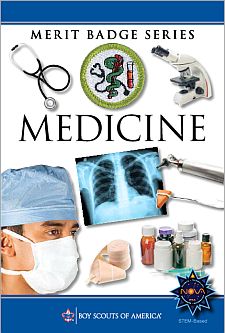- Discuss with your counselor the influence that EIGHT of the following
people or events had on the history of medicine:
- Hippocrates
- William Harvey
- Antoine van Leeuwenhoek
- Edward Jenner
- Florence Nightingale
- Louis Pasteur
- Gregor Mendel
- Joseph Lister
- Robert Koch
- Wilhelm Conrad Roentgen Daniel Hale Williams
- Marie and Pierre Curie Wilhelm Conrad Roentgen
- Walter Reed Marie and Pierre Curie
- Karl Landsteiner Walter Reed
- Alexander Fleming Karl Landsteiner
- Jonas Salk Alexander Fleming
- James Watson and Francis Crick Charles Richard Drew
- Helen Taussig (Note: Dr. Taussig’s name is misspelled as “Raussig” in Boy Scout Requirements and in the Medicine merit badge pamphlet.)
- James Watson and Francis Crick
- Jonas Salk
- Explain the Hippocratic Oath to your counselor, and compare to the original version to a more modern one. Discuss to whom those subscribing to the original version of the oath owe the greatest allegiance.
- Discuss the health-care provider-patient relationship with your counselor, and the importance of such a relationship in the delivery of quality care to the patient. Describe the role of confidentiality in this relationship.
- Do the following:
- Describe the roles the following people play in the delivery
of health care in your state. (Note: Not all may exist in your state.)
- Allopathic Physician
- Chiropractor
- Optometrist Emergency medical technician
- Podiatrist Licensed practical/vocational nurse
- Pharmacist Medical assistant
- Psychologist Medical laboratory technologist
- Physician's assistant Nurse-midwife
- Nurse practitioner
- Nurse-midwife Occupational therapist
- Registered Nurse Optometrist
- Licensed vocational/practical nurse Osteopathic physician
- Medical assistant Pharmacist
- Emergency medical technician Physical therapist
- Medical laboratory technologist Physician's assistant
- Radiologic technologist Podiatrist
- Physical therapist Psychologist
- Occupational therapist Radiologic technologist
- Respiratory therapist Registered Nurse
- Respiratory therapist
- Describe the educational and licensing requirements for five of those in 4a --other than 4a(1)- - practicing health care in your state.
- Describe the roles the following people play in the delivery
of health care in your state. (Note: Not all may exist in your state.)
-
- Tell what is meant by the term "primary care" with regard to
a medical specialty. Briefly describe the types of work done by
physicians in the following "core" specialties:
- Internal medicine*
- Family practice*
- Obstetrics/gynecology*
- Pediatrics*
- Psychiatry
- Surgery
- Describe the additional educational requirements for these specialties.
- Tell what is meant by the term "primary care" with regard to
a medical specialty. Briefly describe the types of work done by
physicians in the following "core" specialties:
-
- Briefly describe the types of work performed by physicians in
FIVE of the following specialties or subspecialties:
- Allergy/immunology
- Anesthesiology
- Cardiovascular disease Cardiology
- Colon and rectal surgery
- Dermatology
- Emergency Medicine
- Endocrinology and metabolism
- Gastroenterology
- Geriatric medicine
- Hematology/oncology
- Infectious disease
- Nephrology
- Neurological Neuro surgery
- Neurology
- Nuclear medicine
- Opthalmology
- Orthopedic surgery
- Otolaryngology/head and neck surgery
- Pathology
- Physical medicine and rehabilitation
- Plastic, reconstructive, and maxillofacial surgery.
- Preventive medicine
- Radiology
- Rheumatology
- Thoracic/cardiothoracic surgery
- Urology
- Vascular surgery
- Describe the additional educational requirements for the five specialties or subspecialties you chose in 6a.
- Briefly describe the types of work performed by physicians in
FIVE of the following specialties or subspecialties:
-
- Visit a physician's office,** preferably one who delivers "primary care." (This may be that of your counselor.) Discuss the components of a medical history and physical examination (an official BSA health form may be used to guide this discussion), and become familiar with the instruments used.
- Describe the characteristics of a good diagnostic test to screen for disease (e.g. routine blood pressure measurement). Explain briefly why diagnostic tests are not perfect.
- Show how to take a blood pressure reading and a pulse reading.
- Do the following:
- Discuss the roles medical societies, employers, the insurance industry, and the government play in influencing the practice of medicine in the United States.
- Briefly tell how your state monitors the quality of health care within its borders, and how it provides care to those who do not have health insurance.
- Compare and discuss with your counselor the health care delivery systems in the United States, Sweden, and China.
- Serve as a volunteer at a health-related event or facility in your community (e.g. blood drive, "health fair", blood pressure screening, etc.) approved by your counselor.
* "Primary care" specialties
** If this cannot be arranged, demonstrate to your counselor that you understand the components of a medical history and physical, and discuss the instruments involved.
For requirement 7a you can click on the
following link to get a copy of the New, Simplified Annual Health and Medical Record
The new form has replaced all previous versions and the former Class 1, 2, and 3 Personal Health and Medical Record Forms.
It is designed to be filled in and saved on your local computer
and then printed out on 8 1/2" x 11" sheets.
Click Here to download the Annual Health and Medical
Record Form
BSA Advancement ID#:
130
Requirements last updated in:
2010
Pamphlet Publication Number:
35917
Pamphlet Stock (SKU) Number:
35825
Pamphlet Revision Date:
2009
| Worksheets for use in working on these requirements: | Format | |
|---|---|---|
| Word Format | PDF Format | |
Page updated on: November 18, 2021









